Our time on P.E.I. draws to a close and we take the short ferry to Nova Scotia, where we decide to concentrate our time on the north island in Cape Breton Highlands. It's the right call; here is a national park deserving of its designation, a park on a grand scale. Mountains meet sea in a rugged coastline, lakes nestle among the woodlands, major geological formations shape the landscape and the bogs and low lying alpine vegetation provide sustenance for the varied wildlife
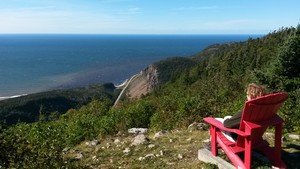 Our first stop is the campground at Chéticamp and while it is nothing special, it does give us the opportunity to hike the
Acadian Trail. Up through the woods, criss-crossing the stream and emerging onto the much more thinly vegetated tops where views
along the coast open up. At a lookout point we find a red adirondack chair. We later find out that the park service have set a
challenge; ten red chairs throughout Cape Breton, looking out over the staff's favourite views. The gauntlet was down; we take
the challenge and have found six before we leave. We'll be back another year to find the other four.
Our first stop is the campground at Chéticamp and while it is nothing special, it does give us the opportunity to hike the
Acadian Trail. Up through the woods, criss-crossing the stream and emerging onto the much more thinly vegetated tops where views
along the coast open up. At a lookout point we find a red adirondack chair. We later find out that the park service have set a
challenge; ten red chairs throughout Cape Breton, looking out over the staff's favourite views. The gauntlet was down; we take
the challenge and have found six before we leave. We'll be back another year to find the other four.
This first rewarding walk was unfortunately followed by a couple of what must be described as fairly boring trails. Usually in a park, descriptions of paths are realistic; there's no need for hype. This didn't always prove to be the case here, one memorable example being a trail described as having "rich Acadian history and spectacular ocean views', neither of which was in evidence when we finally managed to find the completely unmarked beginning of the trail.
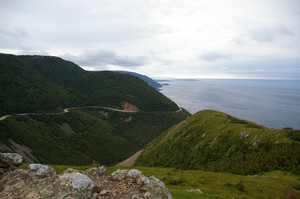 In spite of this, there are plenty of other, truly spectacular trails. The park service have gone to a great deal of trouble
to provide a boardwalk across the headland on the Skyline trail, protecting the fragile vegetation that attracts both moose and
bear. The wind is fierce on the day we make our way down the numerous steps to the view point and few other people venture out,
put off we guess by the gusts. As one cheery person at the top tells us: "We've seen plenty of people go down, but no-one's come
back." The views are worth it but heavy dark clouds are heading our way and we can hear thunder. Being the tallest object on an
exposed headland suddenly doesn't seem such a smart idea and we start back at a clip. The cloud is moving faster than we are and
full waterproofs are needed before too long. We arrive back at the camper thoroughly dripping.
In spite of this, there are plenty of other, truly spectacular trails. The park service have gone to a great deal of trouble
to provide a boardwalk across the headland on the Skyline trail, protecting the fragile vegetation that attracts both moose and
bear. The wind is fierce on the day we make our way down the numerous steps to the view point and few other people venture out,
put off we guess by the gusts. As one cheery person at the top tells us: "We've seen plenty of people go down, but no-one's come
back." The views are worth it but heavy dark clouds are heading our way and we can hear thunder. Being the tallest object on an
exposed headland suddenly doesn't seem such a smart idea and we start back at a clip. The cloud is moving faster than we are and
full waterproofs are needed before too long. We arrive back at the camper thoroughly dripping.
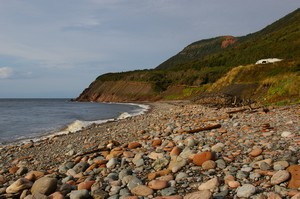 We have left Chéticamp and moved to Corney Brook and it turns out to be the nicest campground we've stayed at in a long month
of Sundays. Small in size and right on the cliffs, it affords views along the coast, up to Cap Rouge in the north. Steps lead
down to the cove, where driftwood lies thrown on the boulder mosaic. The brown peaty waters of Corney Brook push their way
into the sea at one end of the cove, temporarily staining the larger body of water with their dark tannins. Bald eagles fish
here, gliding over the waters looking for lunch while the gannets take a much more direct, vertical approach, plummeting
headlong into the depths after their prey.
We have left Chéticamp and moved to Corney Brook and it turns out to be the nicest campground we've stayed at in a long month
of Sundays. Small in size and right on the cliffs, it affords views along the coast, up to Cap Rouge in the north. Steps lead
down to the cove, where driftwood lies thrown on the boulder mosaic. The brown peaty waters of Corney Brook push their way
into the sea at one end of the cove, temporarily staining the larger body of water with their dark tannins. Bald eagles fish
here, gliding over the waters looking for lunch while the gannets take a much more direct, vertical approach, plummeting
headlong into the depths after their prey.
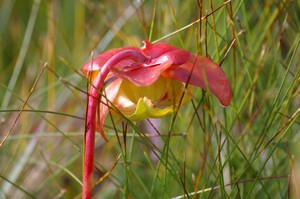 Autumnal shades are gradually appearing and on a bright day we find a stunning display of colour on the short Bog Trail.
Inspite of its somewhat unfortunate name, the area is not in fact a bog, it’s a slope fen with water moving very slowly
through it. It’s a favourite moose haunt but we’re out of luck, the only evidence of their interest being the areas of
vegetation flattened by their large bodies as they rest. The area is covered with low level vegetation punctuated by small
gnarled trees, their growth stunted by poor soils and a cold climate resulting in hundred year old trees a mere three feet
high. The carpet of grass and moss is a rich palette of colour, greens and yellows mixed on a canvas of reflected sky blues
and cloud whites, the pink and red splashes of pitcher plants adding another dimension.
Autumnal shades are gradually appearing and on a bright day we find a stunning display of colour on the short Bog Trail.
Inspite of its somewhat unfortunate name, the area is not in fact a bog, it’s a slope fen with water moving very slowly
through it. It’s a favourite moose haunt but we’re out of luck, the only evidence of their interest being the areas of
vegetation flattened by their large bodies as they rest. The area is covered with low level vegetation punctuated by small
gnarled trees, their growth stunted by poor soils and a cold climate resulting in hundred year old trees a mere three feet
high. The carpet of grass and moss is a rich palette of colour, greens and yellows mixed on a canvas of reflected sky blues
and cloud whites, the pink and red splashes of pitcher plants adding another dimension.
The pitcher plant or Sarracenia purpurea, is incidentally, the provincial flower of Newfoundland and Labrador. First
designated as such in 1954 it’s place of prominence dates back even further. Queen Victoria chose the pitcher plant to be
engraved on a Newfoundland one cent coin minted in 1865.
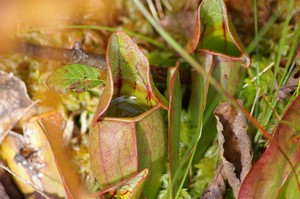
Victorians are known for their reticence when it came to anything physical or sexual. At times this went to ludicrous lengths; so that, for instance, the word leg became unacceptable in polite society because of where they came together at the top. The word limb, used in such a context, originated from this time, as a euphemism for the forbidden appendage. I have even read of the extreme example of a woman sewing covers for the legs of her piano to avoid any embarrassment to her guests. So given this climate it seems a little risque that the matriarch of these mores should pick such a phallic looking plant to be included on the reverse side of a coin carrying her visage. On closer inspection of an image of the particular coin it becomes obvious that any discomfort was avoided by only including the flower stem of the plant, leaving the potentially offending part well out of view.
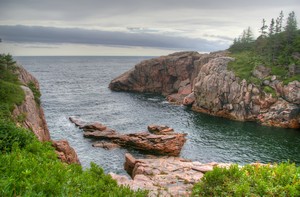 Under overcast skies, we set off on the Coastal Trail and on a round trip of ten kilometres, don't see another soul. This is a
section of the coast only accessible by footpath; exposed pink granite forming delightful coves, cliffs and shelves. Even in the
less-than-ideal light conditions, the dark evergreens on one side and the deep ocean blue on the other show off the wonderful
lines of intruding younger rock, running through the rosy granite. This was one trail description that we could not take issue
with: "Difficult sections across boulder beaches" it claimed and as the third, fourth and fifth ones came into view I groaned.
They make for extremely hard going for anyone and having to rely on sticks for balance makes the going even slower.
Under overcast skies, we set off on the Coastal Trail and on a round trip of ten kilometres, don't see another soul. This is a
section of the coast only accessible by footpath; exposed pink granite forming delightful coves, cliffs and shelves. Even in the
less-than-ideal light conditions, the dark evergreens on one side and the deep ocean blue on the other show off the wonderful
lines of intruding younger rock, running through the rosy granite. This was one trail description that we could not take issue
with: "Difficult sections across boulder beaches" it claimed and as the third, fourth and fifth ones came into view I groaned.
They make for extremely hard going for anyone and having to rely on sticks for balance makes the going even slower.
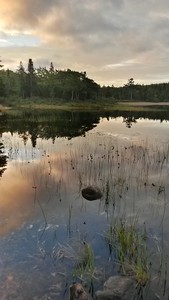 Various other hikes come to mind; we make a dawn visit to Warren Lake pond again motivated by the hope of seeing moose. None of
the large oddly shaped beasts are in evidence but we are rewarded by the gentle colours of sunrise bringing the shallow waters
into view through a pink blush on the surface and the dense woodland crowding the lake coming alive in a flush of gold.
Various other hikes come to mind; we make a dawn visit to Warren Lake pond again motivated by the hope of seeing moose. None of
the large oddly shaped beasts are in evidence but we are rewarded by the gentle colours of sunrise bringing the shallow waters
into view through a pink blush on the surface and the dense woodland crowding the lake coming alive in a flush of gold.
As the autumn approaches, the drive to consume ice cream remains strong, even though so many of the dairy stands have closed
for the season. Sterling is a determined creature when it comes to eating ice cream and while he consumes throughout the winter
months it never seems to be with quite the relish as on a hot, sunny day.
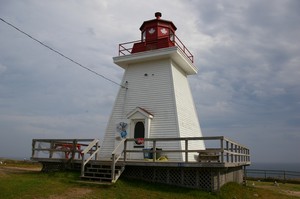 Even with the sea mist drifting in, the find of a
lighthouse that doubles as an ice cream parlour is an opportunity not to be missed. At Neil’s Harbour, the light is still
operational and maintained by the coast guard. The ground floor is now managed by the community, who rent it to the woman
selling the iced confectionary. The coast guard access the light through the shop a few times a year and surely must treat
themselves to a scoop or two, either before or after they tackle the steep wooden ladder disappearing through the hatch in
the ceiling.
Even with the sea mist drifting in, the find of a
lighthouse that doubles as an ice cream parlour is an opportunity not to be missed. At Neil’s Harbour, the light is still
operational and maintained by the coast guard. The ground floor is now managed by the community, who rent it to the woman
selling the iced confectionary. The coast guard access the light through the shop a few times a year and surely must treat
themselves to a scoop or two, either before or after they tackle the steep wooden ladder disappearing through the hatch in
the ceiling.
The mist lifts slightly but the skies remain heavy, threatening rain. We decide to head out of the park to the end of the
Cape Breton Island peninsula and the northernmost settlement in Nova Scotia at Meat Cove. There are various explanations about
the provenance of the name, most having to do with hunting and subsequent butchering or cooking of meat; not perhaps an ideal
destination for a vegetarian.
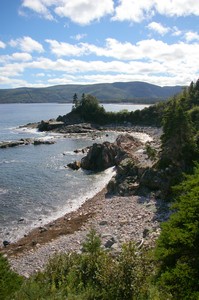 The route skirts the North and South Harbours and the fascinating warren of marsh and inlets
between the two, the whole area protected from the oceans onslaught by the two
barachois sweeping across Aspy Bay.
The final road to the cove is an eight kilometre stretch of gravel with interesting changes in cambre and increasingly large
potholes. The slow progress is worth it. Spectacular dark cliffs dissected by the valley of a small river, surround the cove, a
small commercial campground perching on top of the grassy cliffs.
The route skirts the North and South Harbours and the fascinating warren of marsh and inlets
between the two, the whole area protected from the oceans onslaught by the two
barachois sweeping across Aspy Bay.
The final road to the cove is an eight kilometre stretch of gravel with interesting changes in cambre and increasingly large
potholes. The slow progress is worth it. Spectacular dark cliffs dissected by the valley of a small river, surround the cove, a
small commercial campground perching on top of the grassy cliffs.
On our final day in the park we do a number of short walks, two steep climbs to look outs offering panoramic views and the third on Middle Head; a narrow finger of land extending into the sea and thus separating two bays. With a picnic lunch on a beach, it's a wonderful last day here before we head towards the ferry for the journey over to Newfoundland.